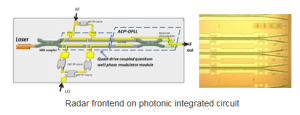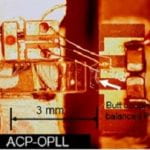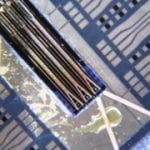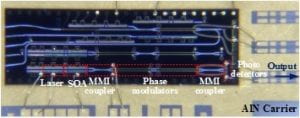Research
RF Photonic Link Immunity to Electromagnetic Interference
The natural immunity of optical fiber to electromagnetic interference (EMI) and high power microwave (HPM) attacks is a critical advantage of RF Photonic links over conventional RF links. The UMass Dartmouth RF Photonics Lab is designing and fabricating components that minimize effects of EMI and HPM while also improving spurious-free dynamic range (SFDR) of RF Photonic links to beyond 120dBHz^(2/3) as is commonly required for military applications.
High Dynamic Range RF Photonic Link 
In advanced radar systems a special analog fiber-optic link connects remote antenna with a
radar signal processor. The optic link provides light weight, low loss and immunity to electro-magnetic interference. However, this application requires a large dynamic range that is beyond the reach of conventional optical links. To solve this difficult problem, we are developing novel RF photonic link with ultra-high dynamic range.
- Hybrid ACP-OPLL Receiver
- Monolithic ACP-OPLL Receiver
Photonic Emulation of RCS and ISAR Measurements
Direct measurements of microwave backscattering properties of electromagnetic (Emag) structures, such as radar cross-section (RCS) and inverse synthetic aperture radar image (ISAR), require a proportionally sized anechoic chamber. Thus, for many large complex Emag structures, direct measurements are impractical. On the other hand, Maxwell’s equations are invariant under dilatation transformation. Thus, it is possible to take measurements of reduced-size scaled models using proportionally higher electromagnetic wave frequencies. By conserving the scale factor between model and wavelength, the measurements for the original and the scaled models are identical.
At UMass Dartmouth, a system scaling both model and wavelength has been designed, tested and operated to perform ISAR and RCS measurements on a tabletop using the near-infrared wavelength.
Integrated Microwave Photonic Transceiver for mmWave Radio
High-frequency mmWave 5G and future 6G (60 to 200GHz) wireless systems have the potential to offer superior latency and throughput over the low-band systems that are dominating today’s 5G markets. However, their deployment is expected to impose stringent challenges, as the high-frequency mmWave radios not only have a limited transmission range, but also are costly to implement using electronic circuitry. To achieve efficient wireless networks, the systems require a massive number of low-cost remote wireless access units tethered by fiber-optic links. The University of Massachusetts Dartmouth (UMassD) proposes a scalable microwave photonic transceiver architecture as o facilitate ultra-wideband wireless access for high-frequency 5G mmWave and future 6G wireless infrastructure.
Chip Level Integrated Photonic Radar Frontend
An entire photonic radar frontend is integrated on a single photonic IC chip. It amplifiers and frequency down-converts the antenna signal to intermediate frequency (IF) band. It is for radar frontend applications where a fiber-optic link is unnecessary. This chip should outperform the electronic radar frontend while maintaining similar size, weight and power efficiency.

Radar frontend on photonic integrated circuit
Microwave Photonic Signal Processor
RF photonics group is developing photonic integrated circuit chips that perform microwave signal processing functions using novel photonic mechanisms. The goal is to develop chip-level integrated photonic microsystems that outperform current microwave millimeter wave integrated circuits (MMIC) and ultimately realize replacement.
Integration Technologies
RF photonics group is investigating integration technologies between heterogeneous material systems including: Si, III-V, and electro-optic crystal wafers such as LiNbO3.
Photonic Component Technologies
RF photonics group is investigating high performance optical modulators, photodetectors and lasers for microwave photonic applications.



